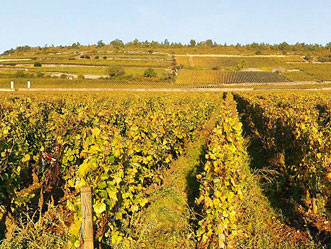

The vineyards of Bourgogne produce some great wines with a historical and international reputation. However, the region is not simply limited to its iconic appellations. In addition to its Village Premier Cru and Grand Cru AOCs, it also produces a range of wonderful Régionale and Village appellations to explore.
You will also find a full list of the Bourgogne’s Climats and lieux-dits on this page.
Check out the complete list of the 84 Bourgogne appellations.
However, your exploration has only just begun. Bourgogne wines have never before offered such high quality. Besides our range of internationally celebrated wines, try some of our lesser-known appellations where there are lots of surprises in store.
And for a fun way to find out more about the wines on offer, try out our “Which Bourgogne wine is right for me?” quiz, or check out Bourgogne Maps to take an interactive tour of the region.
Grand Cru appellation
VIGNOBLE DE LA CÔTE DE BEAUNE
13 juin 1939
White wines only - Chardonnay
Area under production*:
1 hectare (ha) = 10,000 m2 = 24 ouvrées.
BIENVENUES-BÂTARD-MONTRACHET: 3.43 ha.
* in 2018
Appellations Grands Crus of the Côte de Beaune region (Côte-d’Or).
Producing communes:
BIENVENUES-BÂTARD-MONTRACHET: Puligny-Montrachet.
On the label, the words GRAND CRU must appear immediately below the name of any of these appellations in characters of identical size.

White: subtle differences in the wines signal variations in Climat but they also share many common traits. Their colour is gold flecked with emerald, darkening towards yellow with age. Their bouquet evokes butter and warm croissants, bracken, dried fruit, spices and honey. Body and bouquet are not separately distinguishable, so closely blended are structure and harmony into a single perfect whole. Unctuous and firm, dry and caressing, enveloped and profound, these wines combine every virtue in a firmly-established personality.

The power and aromatic persistence of these lofty wines demands aristocratic and sophisticated dishes with complex textures: foie gras, of course, and caviar. Lobster, crawfish, and large wild prawns, with their powerful flavours and firm textures, pay well-deserved homage to the wine and match its opulence. Firm-fleshed white fish such as monkfish would be equally at home in their company. And let us not forget well-bred and well-fattened free-range poultry whose delicate flesh, with the addition of a cream-and-mushroom sauce, will be lapped up in the unctuous and noble texture of this wine. Even a simple piece of veal, fried or in sauce, would be raised to heavenly heights by the Montrachet’s long and subtle acidity.
Serving temperature: 12 to 14°C.

The Montrachet family consists of five Grands Crus grown in the two villages of Puligny-Montrachet and Chassagne-Montrachet. These two share the Montrachet and Bâtard-Montrachet appellations. Chevalier-Montrachet and Bienvenues-Bâtard-Montrachet belong to Puligny-Montrachet, Criots-Bâtard-Montrachet belongs to Chassagne-Montrachet. These Grands Crus are the most southerly of the Côte de Beaune, and lie between Meursault in the North and Santenay in the South.
Their origins go back to the Middle Ages - the work of the Cistercian abbey of Maizières and the Lords of Chagny. The wines of Montrachet (pronounced Mon-rachay) came fully into their own in the 17th century.
There is no argument: this is the finest expression of the Chardonnay grape anywhere on earth ! The appellations Grands Crus date from 31 July, 1937.

The underlying rocks date from the Jurassic, 175 million years BC. Exposures lie to the East and the South. Altitudes: 265-290 metres (Chevalier) ; 250-270 metres (Montrachet) ; 240-250 metres (Bâtard, Bienvenues, Criots). In the
Climat of Montrachet, the soils are thinnish and lie on hard limestone traversed by a band of reddish marl. In Chevalier, the soils are thin and stony rendzinas derived from marls and marly-limestones. In the Bâtard Climat soils are brown limestone which are deeper and, at the foot of the slope, more clayey.
